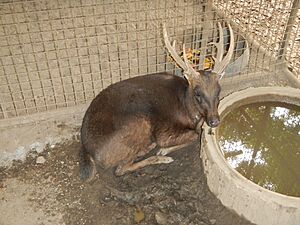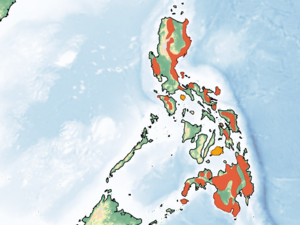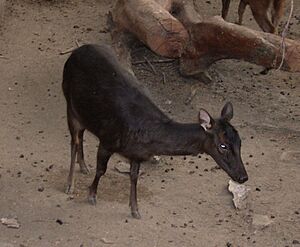Philippine deer facts for kids
Quick facts for kids Philippine brown deer |
|
|---|---|
 |
|
| Conservation status | |
| Scientific classification | |
| Genus: |
Rusa
|
| Species: |
marianna
|
 |
|
| Synonyms | |
|
Cervus mariannus |
|
The Philippine deer (Rusa marianna), also called the Philippine sambar or Philippine brown deer, is a type of deer found only in the Philippines. It is considered a vulnerable species, meaning its population is decreasing and it could become endangered. Scientists first described this deer from groups that were brought to the Mariana Islands, which is why its scientific name includes "marianna."
Contents
About the Philippine Deer
What's in a Name?
The scientific name for the Philippine deer, Cervus mariannus, was first suggested by Anselme Gaëtan Desmarest in 1822. Later, it was placed in the group of deer known as Rusa. There are four main types, or subspecies, of Philippine deer:
- R. m. marianna: Found in the Luzon area.
- R. m. barandana: Lives on Mindoro island.
- R. m. nigella: Found in high mountain areas of Mindanao.
- R. m. nigricans: Lives in lower areas of Mindanao.
How to Spot Them


The Philippine brown deer is smaller than its relative, the sambar deer. From head to body, it measures about 100 to 151 centimeters (around 3 to 5 feet) long. Its shoulder height is usually between 55 to 70 centimeters (about 1.8 to 2.3 feet). These deer typically weigh from 40 to 60 kilograms (about 88 to 132 pounds).
Their fur is generally brown, and they have a white underside to their tail. Male deer usually have antlers that are 20 to 40 centimeters (about 8 to 16 inches) long. Deer living in Mindanao sometimes look a bit different, but scientists are still studying these variations.
Where They Live and What They Need
The Philippine deer is found only in the Philippines. You can find them on islands like Luzon, Polillo, Catanduanes, Mindoro, Samar, Mindanao, and Leyte. Sadly, they might no longer exist on Biliran, Bohol, and Marinduque islands. They are definitely gone from Dinagat and Siargao Islands. Across the Philippines, the deer population is very spread out and much smaller than it used to be.
These deer live on land, from sea level up to high mountains, even at 2,900 meters (about 9,500 feet) high. They like to find food in grassy areas near both old (primary) and new (secondary) forests. However, because forests are being cut down and too many deer are hunted, they are forced to hide in the few remaining forest patches.
Deer in Other Places
The Philippine deer was brought to Guam around 1771-1772 for hunting. From Guam, they spread to other nearby islands in Micronesia, such as Rota, Saipan, and Pohnpei. On Guam, there are no natural predators for the deer, so their numbers grew very quickly. This caused problems for the local plants and farms because the deer ate too much. Now, programs are in place to control the deer population there.
There were also reports of these deer being brought to the Ogasawara Islands in Japan in the late 1700s and 1800s, but they died out by 1925. After World War II, some deer from Guam were brought back to Japan, but they also disappeared years later.
Life and Habits
Daily Life and Diet
Philippine deer are mostly active at night. They look for food like grasses, leaves, and fallen fruits and berries when it's dark. During the day, they rest and hide in the thick parts of the forest.
Reproduction and Family Life
The mating season for these deer usually happens from September to January. During this time, female deer gather in small groups, usually with up to eight deer. Males are attracted to the females by special scents they release. In these busy months, males are very energetic, call out more to females, and prefer to be alone.
Like some other deer, one male will protect an area about the size of a football field from other males. The two males might huff, scrape the ground, and lock their antlers together. These fights usually don't cause serious injury or death, but the males are full of hormones. Many tense meetings between males end with one deer just pretending to charge, and the loser willingly leaves or is chased away from the territory. These territory borders are marked by urinating, leaving droppings in key spots, and rubbing scent glands on plants. Any other male entering another's area is seen as a threat.
After the mating season ends, males often rejoin their small groups of other males. However, some males might spend time alone before joining others. After about six months, female deer give birth to a single baby, called a fawn. The fawn has light-colored spots that disappear after a few weeks.
Cultural Importance and Threats
A Special Animal for People
The Bagobo-Tagabawa tribe in Davao City, Philippines, sees the Philippine brown deer as a "cultural keystone species" (CKS). This means the deer is very important to their culture and way of life. The tribesmen believe their tribe would not be complete without the deer. To protect their cultural heritage and prevent too much hunting, the tribe has set up special hunting and non-hunting areas in the forest.
Dangers They Face
The Philippine brown deer population is shrinking fast because of several threats:
- Habitat Loss: Their homes are disappearing and becoming broken up. This forces the deer to hide in small forest patches where there isn't enough food. While they eat in grasslands, they need the forest shade to hide, especially during the day.
- Low Birth Rate: These deer have only one fawn at a time. This means that if too many are hunted, their population can drop very quickly.
- Hunting: People hunt the deer for their meat, which is often sold. Also, some people use deer antlers as decorations or believe they can treat illnesses like stomach aches, toothaches, or fever. They do this by scraping the antler surface and mixing the powder with water to drink.
Protecting the Philippine Deer
The Philippine deer's conservation status has changed over time. In 1994, it was considered rare. In 1996, there wasn't enough information about it. But since 2008, it has been listed as vulnerable. This is because its population has dropped by more than 30% in the last 24 years. This decline is mainly due to too much hunting, their living areas shrinking, and their habitats being destroyed.
See also


